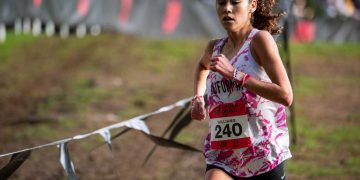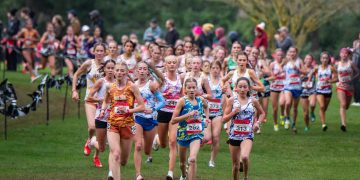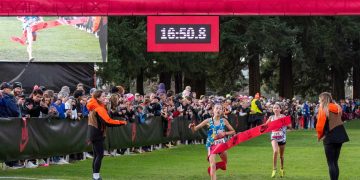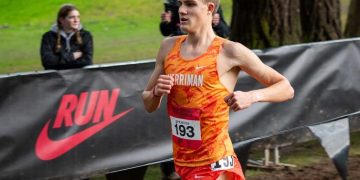This interview was done vie email over June 21-21, 2007, days before she made the team for Osaka. The conditions in Indy were, to say the least, inclement, however, Stuczysnki perseverred, and made the team. The questions were prepared by me, Larry Eder for Jenn and Rick, after her second American record on June 2, 2007. She is a remarkable athlete, and she seems destined for great heights. The relationship between coach and athlete is very focused and is producing results, as the adidas track classic, Reebok GP and AT&T Outdoor showed.
ATF: Jenn–How did you get started in the pole vault?
Jenn: I officially started learning the system that I am trying to currently apply in the spring of 2004. During this time I was also competing in other events for my college track team. I commuted an hour and 45 minutes to lessons during the summer and decided to go back for my masters to finish the year of eligibility I had left. During my graduate program I practiced other events, attended classes, but only pole vaulted on the side. I took the summer of 2005 off and dedicated the upcoming year 2006 for pole vault alone. At first it was not the most supported decision but I trusted my coach Rick Suhr and decided to give it a try.
ATF: What is the biggest lesson that you have learnt in training
for the pole vault?
Rick: I have learned a lot about technique and myself in terms of tendencies, strengths, and weaknesses over the past few years but it is what pole vaulting as a sport has taught me that I cherish the most. I have been taught by Rick to only allow 20 minutes of saddness and pouting after a competition, then it is time to move on. I’ve learned there are ruts and plateus but it is how long you allow them to last that will determine how long you will struggle. The highs are high and the lows are low, but nothing is more exciting that one personal best, wether it is in practice or a meet. This alone will make up for the previous 100 failed attempts at that same height. I have learned a missed bar does not necessarily mean a ‘techncially’ bad jump nor does a made bar directly mean a ‘technically’ good jump. But the most important key lesson that I have learned is to listen to and communicate with my coach. When I am struggling, or I feel I should do more or less lifting, running, or vaulting I need to listen to the coach that has gotten me as far as I am, with that being said, the biggest lesson I have learned is to trust my coach.
ATF: Last summer, when you went to Europe, you told us that the best thing you learnt over there is that you have to plan your big jumps or competitions, tell us about that?
Jenn: Europe is very hard for me. I am still learning and perfecting the pole vault and my technique, therefore I need to practice and have available the drills and equipment that are designed for the system I jump in. However, everything to do this with is in Rochester, my training site. When I plan out my schedule I need to take into account a practice facility, training time, travel, and competition. I do like to come back home if there is a lapse in meets, I call it getting back to neutral. I eat, sleep, and train the way that I am used to. I correct any bad habits I might have developed while continuing to strengthen my weaknesses.
ATF: You said that you felt lethargic the day you cleared 4.84m in Carson City, how did you feel after you cleared the AR?
Jenn: Carson was a very interesting meet for me. Prior to the meet I felt strong, fast, and confident, however, on the day of competition I woke up and noticed my body to be tired. Fighting the wind that day didn’t help either! Once I cleared the American Record at 4.84 I was excited but relieved. I accomplished the one thing that I stated to the public over and over that wanted to do. When I got off the pad I just thought “finallyâ€.
ATF: Are you competitive with the other vaulters?
Jenn: I am competitive with any and all vaulters. If I jump a local meet I want to beat the guys that are jumping. I always want to win but I do understand “you can’t win them allâ€!
ATF: What was it like to vault against Isinbayeva? Feofanova?
Dragila?
Jenn: When I am vaulting I do not really notice anyone in particular. Just as they are focused on their performance I am focused on mine. The one thing I can say though is when vaulting against Yelena Isinbayeve there is much more crowd awareness for the pole vault. Everybody in that stadium, including the announcers, know when she is up, what height the bar is at, and what attempt she is on. When Yelena is jumping the starter waits for her to finish, when anyone else is jumping, they wait for the starter.
ATF: Tell us about the sixteen foot vault. How did you feel that day,
did you know you could clear that height, what about the winds and conditions?
Jenn: I felt strong and relaxed entering Reebok. I knew that my goal was to jump the AR at adidas and 16’ at Reebok. The winds, yes they were all over and they were tricky, at times they caught my pole and twisted my arms and shoulders ( which is an unsettling feeling while you are running full speed about to plant into a small target). However, what it came down to was I wanted to jump 16’ and I wanted to jump it in NYC. I tried to block everything out. It’s funny, my first attempt at 16’ was a much more deliberate jump than the make on my last attempt, it just so happened that the bar stayed in place! Overall though I was very excited and I felt the energy of the crowd which was also rewarding.
ATF: Tell us about the US Outdoor Champs? How do you feel
about the worlds?
Jenn: US Outdoor Championships is a very hard meet for me. Currently, there are 22 female vaulters that are qualified and declared. I will warm-up and wait for a long period of time on the infield before I jump. Last year my goal was to win, this year it is to place top 3 so I can qualify for worlds. As for the World Championships, I have not really thought too much about them… yet. I have to get through one last obstacle this weekend at US Outdoor Nationals and if all goes as planned, I will begin to set goals, arrange my schedule, and prepare.
ATF: You have a long warm up and training before you vault,
tell us about that.
Jenn: My warm up is long, that is very true, I have actually cut it down from last year! I warm up for a meet the exact same way I warm up for practice. I do my ‘form running’ drills, then I do my ‘take-off’ drills, after this I am ready for the runway. I plant the pole but do not swing on it a couple times to establish everything from my mark to my take-off. While doing this, I am also thinking of key things that help me technically as a vaulter. If all goes well from there, I put a bar up. I take some jumps at it and if the day is going well I stop, if not I will go until the officially tells me there is no more time left! Some of my best competitions I never made a bar in warm-up.
ATF: Finally, you have some close ones at 5.03m, how high can you jump?
Jenn: I told everyone I wanted the American Record. I do not want to call out anymore heights. I will be in Europe this summer and I look to jump as well as I can given the circumstances. I do have higher heights in mind, but they will remain a secret between my trainer Rick Suhr and Tim St. Lawrence.
ATF: Rick,You vaulted, tell us abit about your career as an athlete, and your heights?
Rick: My beginnings and my heart were in the sport of wrestling where I was a high school all-american. Pole vault was always a second sport for me, I was a good vaulter but certainly not great. I jumped 16’8â€1/2 when I was 30 years old. I then commited myself to coaching full time.
ATF: How did you get into coaching the vault?
Rick: I opened up a business to train athletes in all sports. As a strength and conditioning coach as well a technical coach. This was in 1992. That business eventually evolved into Suhr Sports which is now primarily a pole vault consultiaton business.
ATF: You had some guy sixteen footers, tell us about them?
Rick: We had a couple sixteen foot guys. Dan Tierney who jump 16+ in high school along with Jason Dahlman who jumped 5 meters+ at Ashland university. I also had Jim Sweich who currently jumps at Roberts Wesleyan College and Dave Fritz who jumped 16+ in the Big East Conference. The guys get limited at my training facility because you can only jump 16’5†because of the height of the roof.
ATF: Is it different coaching a women vaulter as opposed to a male
vaulter?
Rick: It’s basically the same but there are differences. Mainly, the mental focus and the mental appraoch of women is going to be different than that of a man. I found that while men are obviously higher level athletes, women tend to listen and absorb knowledge a little better. I don’t really have a preference on training a male or female vaulters, but the fact that the highest you can jump in my building is 5 meters, we tend to train more women.
ATF: How did you convince Jenn to start vaulting?
Rick: I felt that Jenn was very similar to myself. Jenn had been good at a lot of sports but the one thing that I always wanted to be was to be great at something. I watned to be a pro, to be a professional athlete at the highest level at one thing. I sinmply told Jenn that she was good at a lot of different sports (which she was) but she wasn’t great at any of them, she wasn’t at a pro level. I told her she could be at the highest level in the pole vault. I knew that she would go after it because all athletes want to be great at something.
ATF: Tell us about her early progress?
Rick: Jenn’s early progress was the same as a lot of athletes that have come through our particular system of vaulting. It’s a unique system and Jenn like the others accelerated well. The difference really came because Jenn never had to leave me to go to college. Jenn is the only athlete that has commited to full time training with me without interuption That is what accelerated her beyond the others. All my other athletes had major interuptions in their training whether it was school, college, or dedication.
ATF: Describe your workout center?
Rick: My work out center has been described as Rocky’s Meat Cooler. It is not for the faint hearted. It’s a steal buidling and in the winter time is very cold. We have both an indoor and outdoor runway, we have numerous self-invented apparatuses for dirlls. In the winter time, the insdie temperature will get to 20 degrees warmer than it is outside. The winter is tough, but in the summer this is a great place to train. It’s like a pole vault heaven, if you’re a vaulter it’s just a great place to be.
ATF: Describe your warm up and cooldown before competition?
Rick: Our warm-up can certainly very in time, we try to establish good positioning through take-off, we try to develop a consistent mark, and we try to get some feel for the cross bar in the air. Some meets this only take 15 minutes, some meets it can take 45 minutes. It all depends on how things are going. We always do the same warem-up drills, and the same physical warm up but the time it takes to establish correct positioning always verys. As for cool down, this is something that we need to improve. It is always so difficult after a meet to cool down properly due to fans, media, and regulations.
ATF: Can you give us a typical day in a) early training, b)mid year
c) championship season?
Rick: A) Early Training — Pre season we tend to work on a lot of cardio work and a lot of longer sprinting such as 400s and 200s. We spend about 4 days a week in the weight room and do limited vaulting (maybe once a week)
B) Mid Year — In season training we tend to increase the vaulting to twice a week. We get a lot of physio treatment including chiropractic and massage therarpy. We do continue weight training and aerobic work but not as frequently. Rest becomes a cricitcla element with our in season training.
C)Post Season — Is a time of both mental and physcial recovery. We try to do cross training and other acticities including biking, gymnastics, and aerobic work.
ATF: What have you learnt from Jenn about the pole vault?
Rick: More than anything I wanted an athlete to commit full time to the pole vault so I can train them on a full time basis to find out how my system would work at the highest level. I knew it worked at the youth level, at the highschool level, and and at the college level. We have produced national champs at all of these levels. Many critics questioned whether this system could work at the elite level. Jenn has clearly showed us that this particular style of vaulting works at the absolute highest level. Maybe better at this level than any other level.
ATF: It seems that Jenn can vault in a huge number of circumstances, with bad winds and bad weather, this is unique as most people have to have perfect conditions to compete for a record. Your philosphy seems a bit like compete best you can in any conditions you have and deal with it? Am I correct? Please explain.
Rick: Our system of pole vaulting (Suhr Style) is based upon being forced to learn to vault in very inclement conditions. Because of this, we certainly have an edge in vaulting. We still like to vault in good conditions more than any other and we will jump higher in good conditions but our drop off in bad conditions is not as steep as other styles of vaulting. Most styles of vaulting have been developed in very warm and calm weather conditions.
RelatedPosts
Author
-

Larry Eder has had a 52-year involvement in the sport of athletics. Larry has experienced the sport as an athlete, coach, magazine publisher, and now, journalist and blogger. His first article, on Don Bowden, America's first sub-4 minute miler, was published in RW in 1983. Larry has published several magazines on athletics, from American Athletics to the U.S. version of Spikes magazine. He currently manages the content and marketing development of the RunningNetwork, The Shoe Addicts, and RunBlogRun. Of RunBlogRun, his daily pilgrimage with the sport, Larry says: "I have to admit, I love traveling to far away meets, writing about the sport I love, and the athletes I respect, for my readers at runblogrun.com, the most of anything I have ever done, except, maybe running itself." Also does some updates for BBC Sports at key events, which he truly enjoys.
Theme song: Greg Allman, " I'm no Angel."
View all posts





















